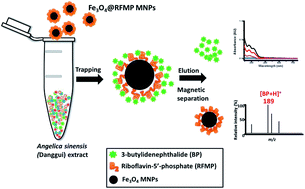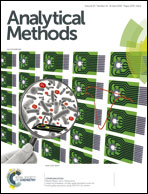Selective extraction of n-butylidenephthalide from Angelica sinensis (Danggui) by using functionalized iron oxide magnetic nanoparticles as trapping probes†
Abstract
n-Butylidenephthalide (BP) is an active compound in Angelica sinensis (Danggui) and a potential anti-cancer drug. Thus, purification of BP from complex herb extract samples is important. In this study, we develop a facile method for selective purification of BP from complex samples by using iron oxide magnetic nanoparticles (Fe3O4 MNPs) immobilized with riboflavin-5′-phosphate (RFMP) as affinity probes. RFMP is a polyaromatic compound that contains a phosphate, which can readily chelate with the metal center on the surface of Fe3O4 MNPs. The aromatic rings on RFMP can interact with BP (Kd = ∼6.73 × 10−5 M) through π–π stacking. Thus, Fe3O4@RFMP MNPs are fabricated by simply mixing Fe3O4 MNPs with RFMP under microwave heating (power: 540 W) for 3 min. The as-prepared Fe3O4@RFMP MNPs can be used as affinity probes to selectively concentrate BP from an acidic solution; BP is then released from the MNPs by using acetonitrile. The recovery of BP from the Fe3O4@RFMP MNP–BP conjugates is estimated to be ∼100%. This study also demonstrates the feasibility of using the proposed approach to selectively extract BP from complex A. sinensis extract samples.



 Please wait while we load your content...
Please wait while we load your content...